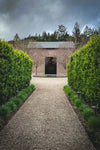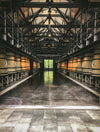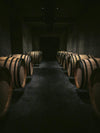Promontory Winery
- WT Travels
- April 2020
Promontory is living, breathing artwork and the masterpiece envisioned by H. William Harlan, and brought to life by the second generation. Arriving in Napa for the first time in 1958, Harlan has nurtured the land and his expertise. The third of a Harlan trilogy, Promontory’s 850 acres today remain a 90% unspoiled California wilderness (a mere 10% of the land is under vine) situated on the converging boundaries of Oakville and Yountville. Home to hawks surfing for prey in the meadows and woodlands standing guard at the sides of the rocky Promontory canyon, the property’s vines thrive in the conundrum of evanescent fog and rugged terrain. There is magic in this Napa paradise, an otherworldliness quality to the land that speaks only through what it gives. A taste of its wine is a weather report and a gift of experience at the intersection of raw and refined, at once dancing and brooding.


A trimmed evergreen hedge and an unassuming gate mark the otherwise indiscernible entrance to the Promontory winery. A short walk down a neatly configured stone path and a vista worthy of paradise found reveals itself. The building is designed to complement the natural surroundings without being architecturally obtrusive. It is, after all, the land that the Harlan family holds dear, and that makes them forever grateful for the opportunity to tend and nurture it. It is clear from the outset that the people and land of Promontory are a harmonious duo in which the land’s caretakers whisper a story in which man learns to appreciate the ever-changing and inconsistent variables nature doles out in a form man seeks to tame in a bottle. To understand Promontory, Mr. Milarezi begins with a geography lesson that includes a discussion of convergence of rock formations and volcanic, sedimentary, and metamorphic soils. He moves to a history lesson including the 200 year plan in which generations of Harlans will be first-growth experts on a property host to a Prohibition Era bootlegging still. Lastly, he ends with an art lesson in which a tasting reveals a son’s aspiration to reveal the true character of this wild territory. The science lesson is reserved for the next stop on the Promontory wine tour—the Fermentation Hall.





The Fermentation Hall
Everything is simultaneously humble and high tech. The exterior’s entrance is shed-like. A stark, discreet metal roof the color of Napa fog rests a top a plain wood structure that blends into the lands sediment that appears to be a purposeful continuation of nature and man’s influence. The large steel cased glass window at the front of the building is framed with a tiny pond and two deciduous trees that, like wine, change with the seasons and are a steady reminder of nature’s role in this endeavor. Enter the structure and a vast geometric steel beam structure looms overhead and a gleaming polished concrete floor grounds the building. Inside the long rows of tanks, quiet magic that can not be seen or heard but only extracted and tasted along the fermentation journey.
A rustically elegant, unassuming structure houses an ultra modern “room where it happens” industrial wine fermentation center filled with cement, steel, and French custom made tanks. The Harlans, like in their Harlan and Bond vigneron pursuits and in line with the best practices of the Grand Cru Bordeaux producers, take the slow and slower approach from bottle to market. The long aging curve in a cool—rather than cold—environment creates ideal conditions for a wine to spend time before release. Promontory wines are expected to age gracefully in the bottle. Tannins in the wines act as natural preservatives. Chemical compounds in wine change over time, and a controlled anaerobic (an absence of free oxygen) environment causes tannins in the wine to lose their “fight” and mellow. The longer a wine is allowed to age, the mellower and more complex the wine can become. During fermentation, the Promontory barrels are rotated several times a day. Color, flavor, and tannins from the skins are slowly infused into the wine over time. The slow and steady approach from vine to barrel to bottle and then cellar is a nearly five year program that reduces the typical French oak barrel aging from 24 months to to 9 months, moves the wine to 820 gallon Stockinger Austrian oak casks to complete the patient five year plus vine to bottle to market cycle.
It is also time that provides Promontory vintages with the alchemy needed for the wine to age gracefully—what begins in wild territory, culminates in a seductive, all-American sense of place in its taste that sits deservedly in the company of the finest wines of the world. So certain of their inherent quality, the Harlans have reserved forty percent of the production today (25,000 bottles) to be exported and sold through the La Place de Bordeaux, a peculiar Old World gate keeping system in which supply and demand rules. Every April, Brokers, châteaux, and merchants meet to insure that the finest wines in the world are sold ‘en primeur’— wine not yet bottled is tasted directly from the cask. This system grants merchants first access and therefore the most competitive prices, the châteaux is removed from selling its own wine and able to focus exclusively on growing rather than distribution, and the end consumer benefits from quick access to newly released vintages through a select number of brokers intent on getting a return on investment as quickly as possible.


The Promontory wine tour ends in a handsome tasting room with a brooding, moody panoramic photograph of the Promontory landscape setting the tone of the tasting. Each wine poured incites excitement of the senses. These are vivacious and seductive wines. Time and place are captured in a bottle with tasting notes that include evocative words such as “fleshy”, “intense”, “chiseled”, “intertwined”, “youthful” and “muscle.” Long after a visit to Promontory, memories linger of learning to taste fog, to smell youth, and to experience years gone by in a bottle. Like art, Promontory wine is the Harlans’ form of creative human expression, a way of enriching the human experience by tending vines and creating a lasting impression. Promontory is Napa Valley Territory in all its unadulterated glory.